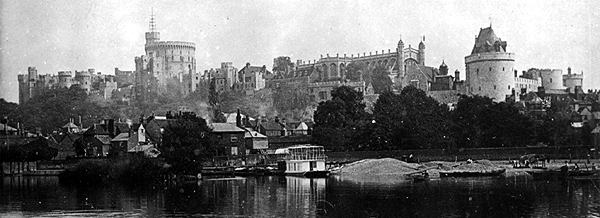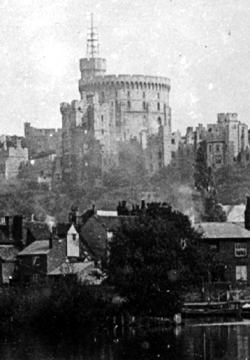The Royal Standard
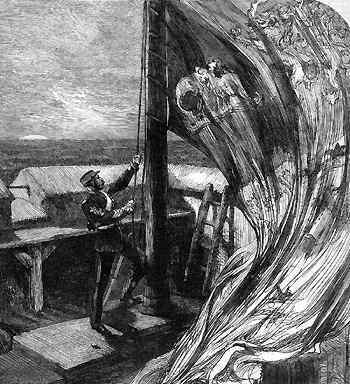
Hoisting the Royal
Standard at Windsor Castle at sunrise on the Prince of Wales's
Marriage Day, an event not to be repeated for over 140 years!
The dramatic illustration
above is taken from the front cover of The Illustrated London
News of March 14th 1863 and was published at the time of the
wedding of The Prince of Wales, the future King Edward VII, on
March 7th 1863 to Alexandra, the eldest daughter of King Kristian
IX of Denmark. Their second son, George (1865-1936) was to become
George V.
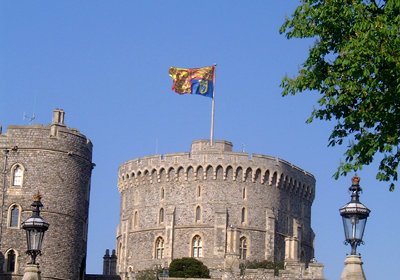 The massive ceremonial
Royal Standard flies over Windsor Castle, April 21st 2005
The massive ceremonial
Royal Standard flies over Windsor Castle, April 21st 2005
In glorious weather, the
great ceremonial Royal Standard flew over Windsor Castle on April
21st 2005 by way of a salute to Queen Elizabeth on the occasion
of her 79th birthday. The photo above does not really do justice
to this flag's immense size. It measures 38 feet (11.58 meters)
across by 19 feet (5.79 meters) deep and flies only on very special
occasions. Certainly the Queen's Birthday, her real birthday,
is one such occasion, and another is the day of the Garter Service
in mid-June. Also, earlier in April 2005, the flag had been flown
to mark the wedding of HRH Prince Charles to the Camilla Parker
Bowles, the Duchess of Cornwall. On other occasions a smaller
version of the Royal Standard is flown.
The Royal Standard is only flown when the monarch
is actually present, either at one of her official residences
such as Windsor or Buckingham Palace, on the Queen's car while
undertaking official journeys and even on an aircraft, but only
while taxiing! Other members of the Royal Family have their own
variants of the Royal Standard plus versions for use in Wales
and Scotland. When the Queen is not present at Windsor, the Union
flag is flown, the size selected according to the strength of
the wind.
During the programme 'Windsor: The Queen's Castle' shown by the BBC in Spring 2005, the Flag Officer
at Windsor, Tony Martin, is seen watching for the arrival of
the Queen within the grounds of Windsor Castle. Her arrival is
his signal to lower the Union flag and raise the Royal Standard.
While being filmed Mr Martin was seen raising the huge ceremonial
Royal Standard. "Some flag this," he says, "You
can see this from Heathrow." Heathrow Airport is some 5
miles from Windsor Castle!
The Royal Standard is split
into four quadrants. The quadrants at top left and bottom right
represent England featuring three gold lions on a red field;
the second quadrant (top right) represents Scotland and features
a red lion rampant on a gold field; the third quadrant (bottom
left) represents Ireland and features a gold harp on a blue field.
Wales is not featured on the Royal Standard, as it is a Principality
not a kingdom and as such predates the Union of Ireland, Scotland
and England by several centuries. In Scotland the Royal Standard
features two Scottish quadrants instead of the two representing
England.
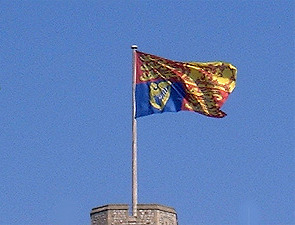 The Royal Standard is split into
four quadrants described above
The Royal Standard is split into
four quadrants described above
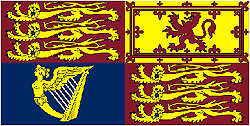
Flying the Union Flag
at Half Mast
It is often believed that all flags should
be flown at half mast on the occasion of the death of the monarch
as a sign of mourning. This does not apply to the monarch's flag,
the Royal Standard. It was therefore impossible for the flag
to be flown at half mast on the occasion of Diana, Princess of
Wales', death.
"The King is Dead! Long Live the King."
This apparent contradiction actually illustrates the point in
that at the very moment of the passing of a monarch, his or her
descendant immediately accedes to the throne, thereby ensuring
uninterrupted monarchy and succession. On the day a new monarch
is proclaimed, normally within a few days of the death of the
preceding monarch, the union flag is flown 'full mast', from
the top of the flag staff, from 11.00a.m. to sunset.
On public buildings, flying a flag at 'half mast'
indicates the death of the sovereign or funeral of members of
the Royal Family, the funerals of foreign rulers and the funerals
of Prime Ministers and ex-Prime Ministers. There can also be
special commands from the sovereign altering these arrangements
at times of national or international disaster such as following
the events of September 11th 2001, pictured below.
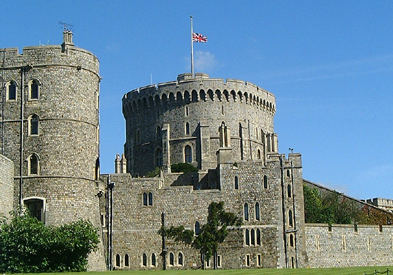
Following the terror
attacks in America on September 11th 2001, the Union flag over
Windsor Castle was flown at 'half mast' as a sign of national
mourning.
More details.
Half mast means the flag is actually lowered
by one third of the height of the flag staff. This can be seen
clearly in the picture above. Whenever the Union flag is flown
at 'half mast' it is first raised to the top of the mast and
then lowered by one third of the height of the mast. It must
remain moving throughout this procedure.
More about the Union Flag

The Union Flag is described as 'the people's
flag' and is accepted worldwide as the national flag of the United
Kingdom. The four countries comprising the United Kingdom are
Scotland, Ireland, England and Wales, each of which have in addition
their own flags. Since the creation of the Irish Republic, the
Union flag now represents Northern Ireland which remains part
of the United Kingdom. Although the Union Flag has never been
officially declared to be the United Kingdom's national flag,
it is of course the flag that is always waved at, say, The Last
Night of the Proms or along processional routes and flown from
flagpoles to mark a national event.
The Union Flag was originally a combination of the
red and white cross of St George (England) and the blue and white
cross of St Andrew (Scotland). This form of the flag dates from,
with some variations, the union of England and Scotland at the
time of James I of England (who was also James VI of Scotland)
in 1605. The red and white cross of St Patrick was incorporated
in 1801 following the union with Ireland. The reason why Wales
is not represented is that England and Wales had been an amalgamated
kingdom since Edward I defeated Llewelyn resulting in the Treaty
of Aberconwy in 1277.
The prime purpose of the new flag at that time was
to identify British ships at sea and so a proclamation was issued
on 12th April 1606 that all ships shall fly a flag comprising
the English cross of St George and the Scottish cross of St Andrew,
and a design was created. This did not please everyone as the
cross of St Andrew was thought to be obscured by the English
flag, and similarly the English were unhappy at the loss of the
white background for St George's red cross and so a number
of variants were proposed but by 1801, upon the union with Ireland,
the flag we know today was created. [More information].
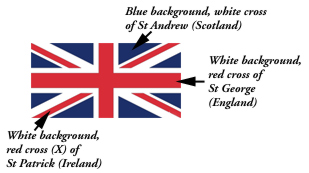
The three component parts of the
Union flag.
In this picture, the flag pole would be to the left to ensure
that the flag is flown the right way up.
The British flag is sometimes referred
to as the Union Jack. Many believe that this is wrong and that
the term 'jack' should refer only to the flag when flown aboard
ship. A little known detail dates from 1902 when the Admiralty
declared that the flag could be known as both the Union Flag
and the Union Jack, its first name from the earliest days in
1606.
The Union flag takes precedence over all other flags
and must always be flown from the 'senior' flag staff, i.e. the
highest of a group, or the flag pole to the left.
Flying one flag beneath another means that the lower
flag has been defeated in battle.
Flags flown upside down have always indicated 'I
am in distress' and is primarily a naval signal. Other vessels
in the area would then offer assistance if they were in a position
to do so. In order to ensure that the flag is flown correctly,
the broader diagonal white stripe should be to the left, at the
top, nearest the flagpole.
Flag Days
in the UK - Union Flag
| January |
20th |
Birthday
of The Countess of Wessex |
| February |
6th |
Her
Majesty's Accession Day |
| |
19th |
Birthday
of the Duke of York |
| March |
2nd
Monday |
Commonwealth
Day |
| |
10th |
Birthday
of the Earl of Wessex |
| April |
21st |
Birthday
of Her Majesty the Queen |
| |
23rd |
St
George's Day (St George's Cross) |
| June |
2nd |
Coronation
Day |
| |
Variable |
Official
celebration of Her Majesty's
Birthday |
| |
10th |
Birthday
of Duke of Edinburgh |
| August |
15th |
Birthday
of The Princess Royal |
| November |
2nd
Sunday |
Remembrance
Day |
| |
14th |
Birthday
of Prince of Wales |
| |
20th |
Her
Majesty's Wedding Anniversary |
With
thanks to Harrison External Display Systems for the above
Their web pages may be found at www.flagpoles.co.uk |
Maintaining the Flag Staff
Elsewhere on The Royal Windsor Web Site
we feature the story of Billy Wilkins who was to be seen every so
often perched aloft suspended from the flag staff at Windsor,
bees-waxing the flag pole! Despite this loving care, the flag
staff has had to be replaced from time to time. One such occasion
was in 1892. It is understood that the 'button', the large circular
cap from the top of this flag pole was in the care of the Constitution
Club in Windsor for many years.
Additional photographs
and information about the flags and flag staff at Windsor are
being prepared. The loan of your photographs, especially of Billy
Wilkins, would be very much appreciated.
|









